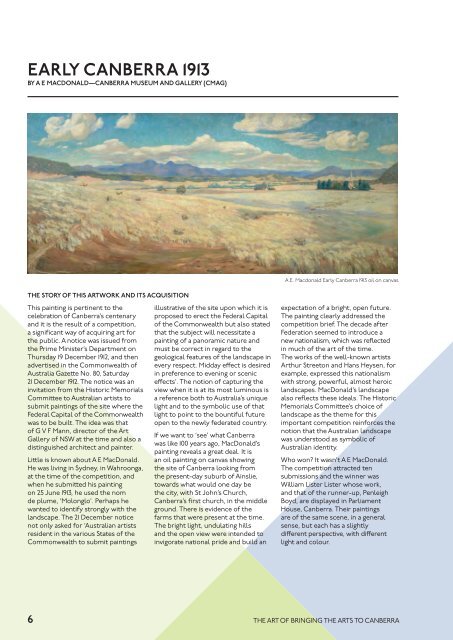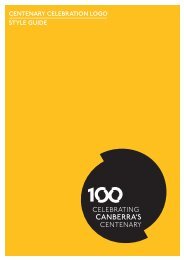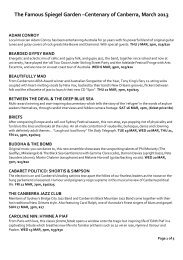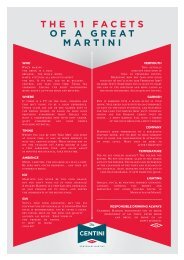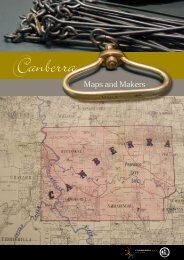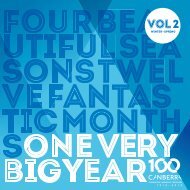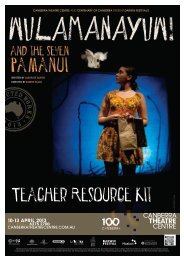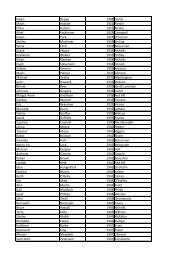THE ART - Canberra 100
THE ART - Canberra 100
THE ART - Canberra 100
Create successful ePaper yourself
Turn your PDF publications into a flip-book with our unique Google optimized e-Paper software.
EARLY CANBERRA 1913<br />
BY A E MACDONALD—CANBERRA MUSEUM AND GALLERY (CMAG)<br />
A.E. Macdonald Early <strong>Canberra</strong> 1913 oil on canvas<br />
<strong>THE</strong> STORY OF THIS <strong>ART</strong>WORK AND ITS ACQUISITION<br />
This painting is pertinent to the<br />
celebration of <strong>Canberra</strong>’s centenary<br />
and it is the result of a competition,<br />
a significant way of acquiring art for<br />
the public. A notice was issued from<br />
the Prime Minister’s Department on<br />
Thursday 19 December 1912, and then<br />
advertised in the Commonwealth of<br />
Australia Gazette No. 80, Saturday<br />
21 December 1912. The notice was an<br />
invitation from the Historic Memorials<br />
Committee to Australian artists to<br />
submit paintings of the site where the<br />
Federal Capital of the Commonwealth<br />
was to be built. The idea was that<br />
of G V F Mann, director of the Art<br />
Gallery of NSW at the time and also a<br />
distinguished architect and painter.<br />
Little is known about A E MacDonald.<br />
He was living in Sydney, in Wahroonga,<br />
at the time of the competition, and<br />
when he submitted his painting<br />
on 25 June 1913, he used the nom<br />
de plume, ‘Molonglo’. Perhaps he<br />
wanted to identify strongly with the<br />
landscape. The 21 December notice<br />
not only asked for ‘Australian artists<br />
resident in the various States of the<br />
Commonwealth to submit paintings<br />
illustrative of the site upon which it is<br />
proposed to erect the Federal Capital<br />
of the Commonwealth but also stated<br />
that the subject will necessitate a<br />
painting of a panoramic nature and<br />
must be correct in regard to the<br />
geological features of the landscape in<br />
every respect. Midday effect is desired<br />
in preference to evening or scenic<br />
effects’. The notion of capturing the<br />
view when it is at its most luminous is<br />
a reference both to Australia’s unique<br />
light and to the symbolic use of that<br />
light to point to the bountiful future<br />
open to the newly federated country.<br />
If we want to ‘see’ what <strong>Canberra</strong><br />
was like <strong>100</strong> years ago, MacDonald’s<br />
painting reveals a great deal. It is<br />
an oil painting on canvas showing<br />
the site of <strong>Canberra</strong> looking from<br />
the present-day suburb of Ainslie,<br />
towards what would one day be<br />
the city, with St John’s Church,<br />
<strong>Canberra</strong>’s first church, in the middle<br />
ground. There is evidence of the<br />
farms that were present at the time.<br />
The bright light, undulating hills<br />
and the open view were intended to<br />
invigorate national pride and build an<br />
expectation of a bright, open future.<br />
The painting clearly addressed the<br />
competition brief. The decade after<br />
Federation seemed to introduce a<br />
new nationalism, which was reflected<br />
in much of the art of the time.<br />
The works of the well-known artists<br />
Arthur Streeton and Hans Heysen, for<br />
example, expressed this nationalism<br />
with strong, powerful, almost heroic<br />
landscapes. MacDonald’s landscape<br />
also reflects these ideals. The Historic<br />
Memorials Committee’s choice of<br />
landscape as the theme for this<br />
important competition reinforces the<br />
notion that the Australian landscape<br />
was understood as symbolic of<br />
Australian identity.<br />
Who won? It wasn’t A E MacDonald.<br />
The competition attracted ten<br />
submissions and the winner was<br />
William Lister Lister whose work,<br />
and that of the runner-up, Penleigh<br />
Boyd, are displayed in Parliament<br />
House, <strong>Canberra</strong>. Their paintings<br />
are of the same scene, in a general<br />
sense, but each has a slightly<br />
different perspective, with different<br />
light and colour.<br />
6 <strong>THE</strong> <strong>ART</strong> OF BRINGING <strong>THE</strong> <strong>ART</strong>S TO CANBERRA


